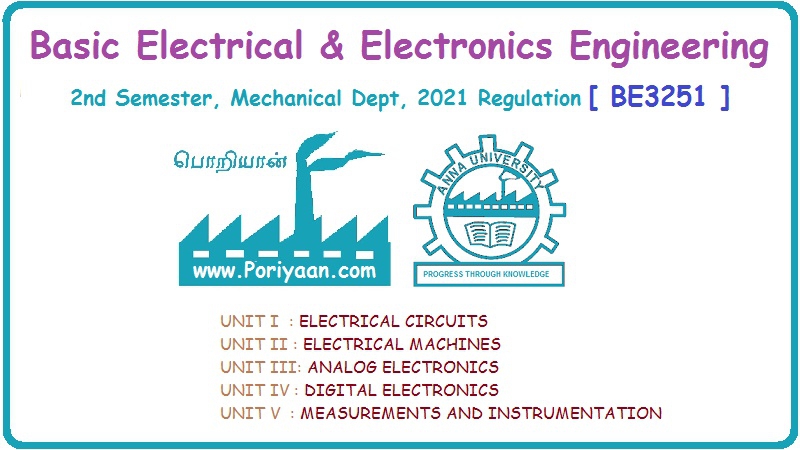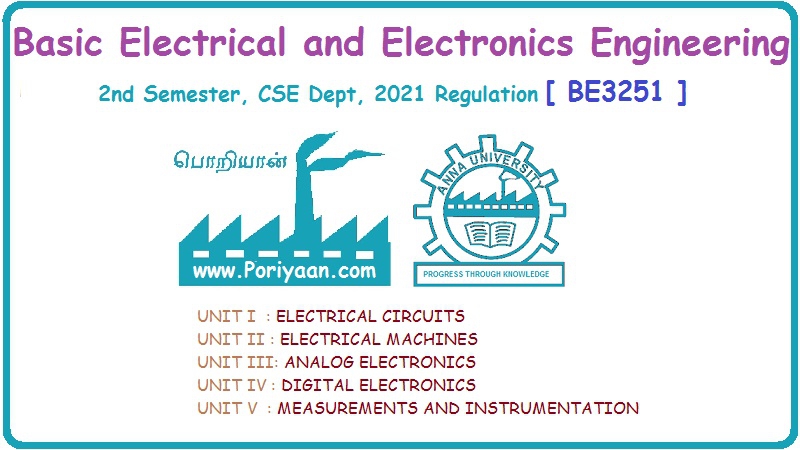Basic Electrical and Electronics Engineering: Unit III: Analog Electronics
Half Wave Rectifier
Circuit diagram, Operation, Formula, Calculation, Advantages, Disadvantages
Half wave rectifier consists of step down transformer, PN junction diode and load resistance.
HALF WAVE RECTIFIER
Half wave rectifier consists of step down transformer, PN junction diode and load resistance. This involves a device that only allows one-way flow of electrons. The simplest kind of rectifier circuit is the half-wave rectifier. It only allows one half of an AC waveform to pass through the load.
Operation
During the positive half cycle, D is forward biased and output voltage is the same as the input voltage. In the negative half cycle, D is reverse biased, and output voltage is zero.
Entire transformer voltage appears across the diode. The maximum voltage across the diode is Vm. The diode must be capable to withstand the voltage. Therefore PIV half waverating of diode should be equal to Vm in case of phase rectifiers. The average current rating must be greater then Iavg.
Average DC current and voltage (IDC & VDC).
Average value = Area under the curve / Time period
Io = Im sin ωt
Io = 0
= Im/2π[-cos ωt]0π = Im/2π[1+1]
DC output voltage,
VDC = IDCRL
= Im/2π RL
= Vm R1/π (R1+RF)
Vdc = Vm/π
RMS value of the current IRMS
= √Im2/4
IRMS = Im/2
VRMS = IRMS . RL
= Im/2.RL
= Vm . R1/2(Rℓ+Rƒ)
VRMS = Vm/2
DC output power PDC :
PDC = Im2 /π2 RL
AC input power PAC :
PAC = Pa + Pr
Pa = I2RMS Rƒ = I2m Rƒ
Pr = I2RMS.RL = Im2 RL
PAC = I2m/4.Rƒ = I2m/4 RL
PAC = I2m/4 (Rƒ + RL)
Efficiency (n):
Ratio of the DC out power to AC input power is called as efficiency. It is denoted as n. It is always expressed in terms of percentage.
η = Pdc/ Pac × 100
= 4/ π2
= 0.406 × 100 = 40.6%
Efficiency (η) = 40.6%
The maximum possible efficiency of a half wave rectifier is 40.6%.
Frequency component in the rectifier output:
Fourier analysis of half wave rectifier output load current is given by
iL = Im [1/ π + ½ sin ωt - ⅔π cos2 ωt - 2/15π cos 4ωt………]
First term represents DC component, second term onwards low frequency AC components are called ripple components. Thus the rectifier output contains DC component and AC ripple components.
Im/π is DC component = ½ sin ωt - ⅔π cos2 ωt - 2/15π cos 4ωt is low frequency unwnted ac component or ripple components.
Ripple Factor (γ):
It is the ratio of the rms value of ac component to the average value of dc component.
γ = rms value of AC component / average value of DC component
γ = Iac / Idc
The rms value of total load current is given by
IL = √I DC 2 + I12 + I22 + I42 +.....
IL = IL √ Idc2 + Iac2
IAC = √ IL2 + Idc2=
γ = Iac / Idc
W.K.T = IL / IDC From factor
= ILRMS = Im/2 , IDC = Im/ π
γ = √(π/2)2-1
= √(1.57)2-1
γ = 1.21
Peak Inverse Voltage (PIV):
When the diode in reverse bias condition the maximum voltage across the diode is called peak inverse voltage (PIV).
When the diode is reverse bias it acts as an open circuit. So, some drop across the diode but current is zero.
PIV = Vm
Transformer Utilization Factor (TUF):
It is the ratio of DC power deliver to the load to the AC power rating of the transformer secondary.
TUF = DC power deliver to the load / AC power rating of the transformer secondary
=Pdc/Pac (rating)
Substitute Im = Vm /RL+RF = 2/π2
TUF = 0.286
Regulation:
Regulation is defined as variation of output voltage with change in load current. It is denoted as R. it is expressed interms of percentage (%).
Percentage of Regulation (R%) = VnL-VL/VL ×100
VnL = no load voltage
VL = load voltage
VnL = Vm/π
= IDC RL
= Im/π .RL
% R = Rƒ/RL ×100
Advantages:
• Simple circuits
• Low cost
Disadvantages:
• Low efficiency
• High ripple facto
• Low TUF
Basic Electrical and Electronics Engineering: Unit III: Analog Electronics : Tag: : Circuit diagram, Operation, Formula, Calculation, Advantages, Disadvantages - Half Wave Rectifier
Related Topics
Related Subjects
Basic Electrical and Electronics Engineering
BE3251 2nd semester Mechanical Dept | 2021 Regulation | 2nd Semester Mechanical Dept 2021 Regulation
Basic Electrical and Electronics Engineering
BE3251 2nd Semester CSE Dept 2021 | Regulation | 2nd Semester CSE Dept 2021 Regulation

